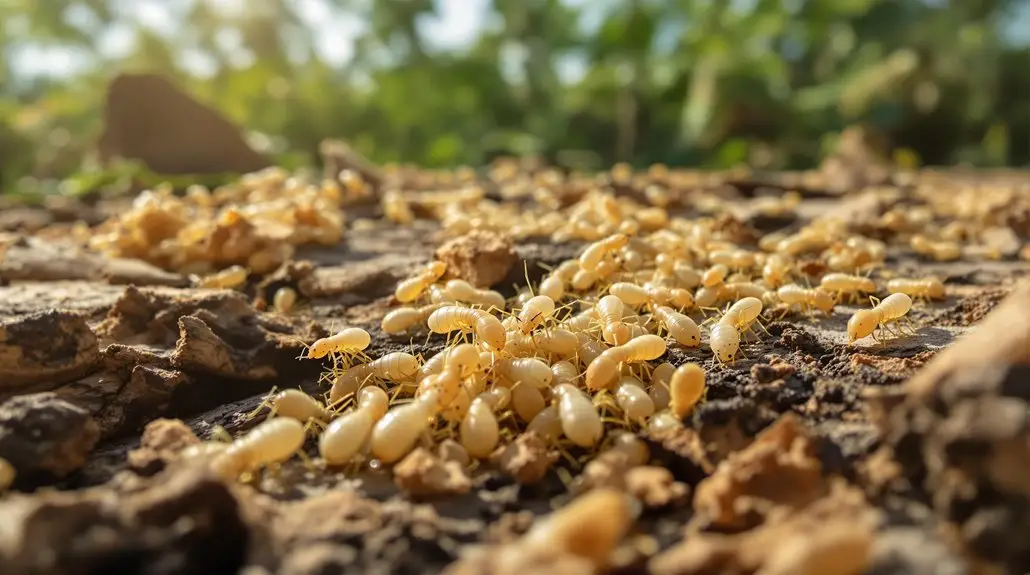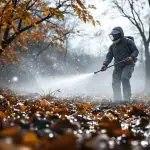Imagine a hidden colony of termites silently munching away at the wooden structures of homes, threatening your investment and security. The Formosan subterranean termite, notorious for its rapid reproduction and destructive nature, poses a severe challenge in South Florida, where it causes around $2 billion in damages each year. Understanding its impact, behavior, and the complexities of managing this pest is essential for homeowners and communities alike.
Key Insights
- Formosan termites cause approximately $2 billion in damages annually, leading to significant repair costs for homeowners in South Florida.
- Their expansion in urban areas increases infestation risks, particularly in the densely populated Miami-Fort Lauderdale region.
- Hybridization with other termite species complicates management efforts and raises the potential for more aggressive infestations.
- The complex social structure of Formosan termites allows colonies to grow rapidly, with millions of individuals consuming large amounts of cellulose materials.
- Limited insurance coverage for termite damage exacerbates financial burdens on homeowners and local businesses facing increased pest control costs.
Economic Impact of Formosan Termites
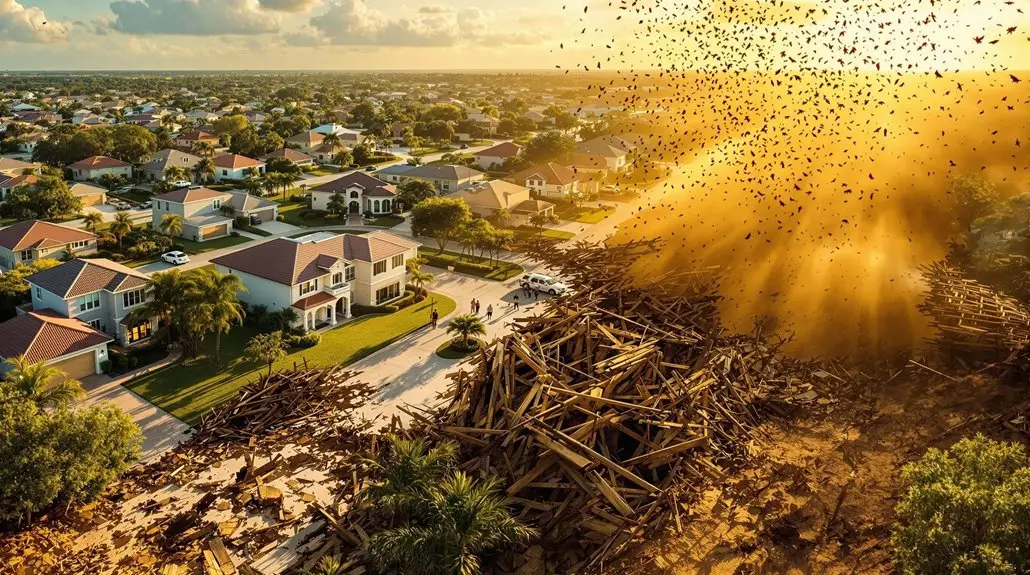
As the presence of Formosan termites continues to grow in South Florida, understanding their economic impact becomes increasingly essential for homeowners and local businesses alike. These pests impose substantial costs, amounting to millions of dollars annually, as homeowners face significant expenses for repairing structural damage. Additionally, property values may decline due to infestations, directly affecting local economies and making homes less marketable. Regular inspections and maintenance, though necessary, add to the financial burden, especially since insurance coverage for termite damage is often limited or nonexistent. For local businesses, the increased costs associated with termite prevention and control measures can hinder profitability, while the threat of structural issues may deter potential investments. Overall, these economic consequences extend beyond individual households, impacting regional growth. As Formosan termites feed on wood and cellulose-based materials, the resulting damage can lead to costly repairs and a greater economic strain on communities. Implementing holistic pest management strategies can help mitigate these costs and minimize the risk of infestations.
Geographic Spread and Infestation Risks
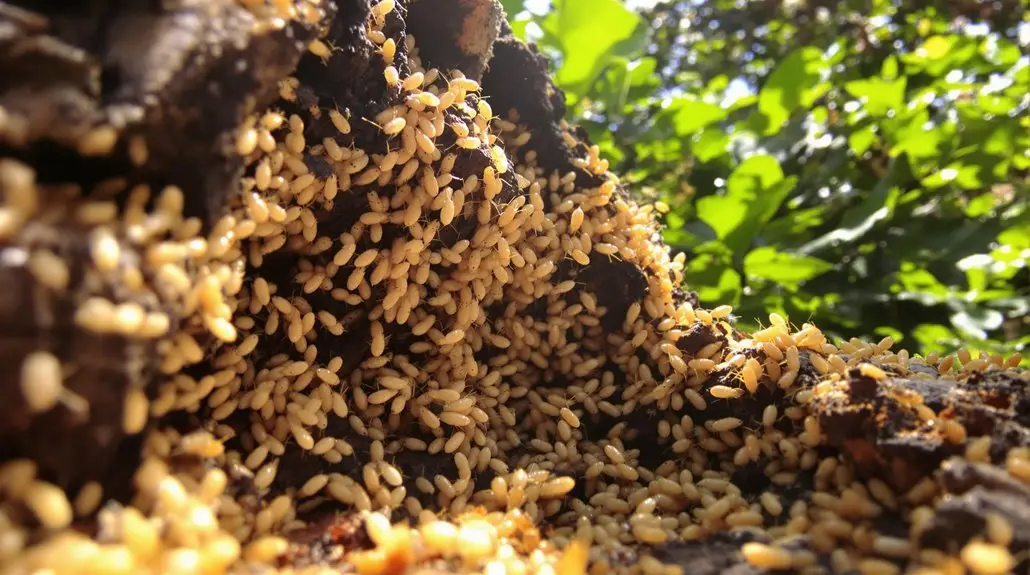
As Formosan termites expand into new areas, their presence poses increasing infestation risks, particularly in South Florida. The overlap of their range with existing termite populations raises concerns about potential hybridization, which could further complicate management efforts. Understanding these geographic patterns is essential for developing effective strategies to mitigate the risks associated with these invasive pests. Subterranean termite activity is predicted to increase in South Florida over the next two decades, highlighting the urgency of addressing this growing problem.
Expansion Into New Areas
While the geographic spread of Formosan subterranean termites poses a significant threat to structures across South Florida, understanding the factors contributing to their expansion is essential for effective management. These termites thrive in the mild climate of Florida, allowing them to establish colonies in all major urban areas, particularly in Dade, Broward, and Palm Beach Counties. They can extend their range along coastlines, increasing the risk of infestation in new areas. Human activities, such as construction and landscaping, often inadvertently transport termite-infested materials, while transportation hubs facilitate the movement of these pests. With their ability to infest structures rapidly and create severe damage, maintaining vigilance through regular inspections is vital to prevent widespread infestation and economic loss. The substantial economic loss associated with these termites highlights the urgency of implementing effective control measures.
Overlap in South Florida
The overlapping presence of Formosan and Asian subterranean termites in South Florida creates a unique and concerning situation for residents and property owners, especially given the considerable risk of extensive structural damage these pests pose. This geographical overlap, particularly concentrated in the Miami-Fort Lauderdale area, places approximately 6 million residents at risk. Both termite species are capable of establishing large colonies quickly, making infestations difficult to detect without thorough inspections. They can compromise not only wooden structures but also penetrate concrete homes through vulnerabilities. The environmental impact includes damage to native tree canopies, with reports indicating that 50% of native pines in Fort Lauderdale are infested. As these termites thrive in South Florida’s subtropical climate, their presence disrupts local ecosystems considerably. The combined damage from Asian and Formosan termites is estimated at $40 billion worldwide, underscoring the urgency of addressing this growing problem.
Hybridization Risks Increase
Hybridization between Formosan and Asian subterranean termites poses significant geographic spread and infestation risks, raising concerns for both ecosystems and property in South Florida. This hybridization occurs due to the absence of pre-zygotic barriers, allowing for the formation of heterospecific colonies that exhibit both intermediate and cumulative traits from their parent species. Laboratory findings indicate that these hybrid colonies often demonstrate increased growth rates and hybrid vigor, leading to faster development and dispersal compared to their parental counterparts. Field observations reveal the persistence of hybrid populations, even in sterile alate cases, suggesting potential gene flow and long-term ecological impacts. With the ability to infest structures more quickly, these hybrids heighten the urgency for effective management strategies to mitigate their spread and associated economic damages. Additionally, ongoing research indicates that hybridization consequences from human activity can exacerbate the spread of these invasive pests.
Biological Characteristics and Behavior
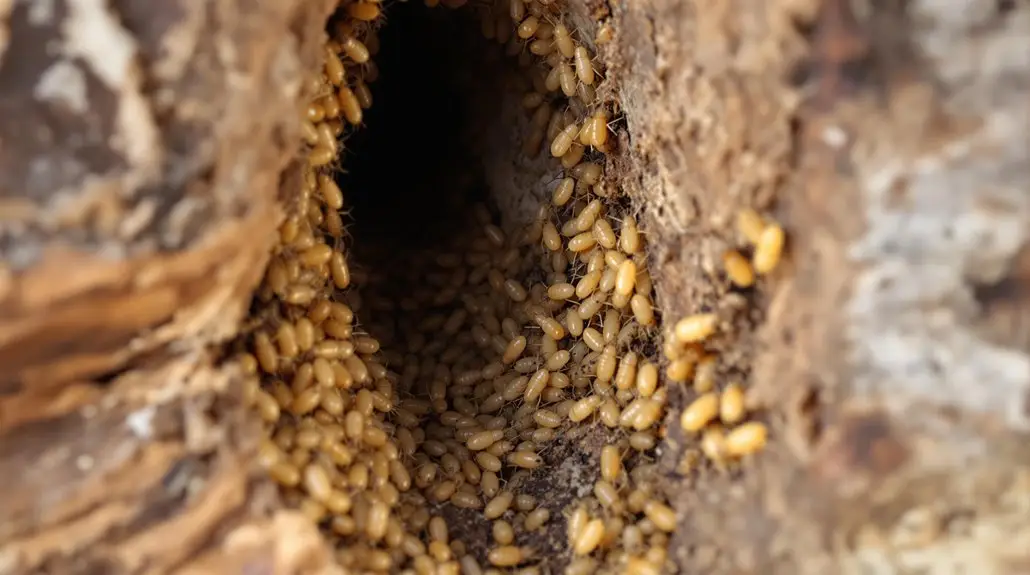
Understanding the biological characteristics and behavior of Formosan subterranean termites is essential for effective management and control, as these insects exhibit unique traits that contribute to their rapid and extensive damage capabilities. Colonies can number in millions, allowing them to consume vast amounts of cellulose-rich materials, including wood, paper, and even certain plastics. Formosan termites, larger than other species, thrive in damp environments, constructing carton nests above ground and intricate mud tubes for protection. Their complex social structure consists of three castes: reproductives, soldiers, and workers, each playing a vital role in colony survival. Alates swarm at night, promoting reproduction, while soldiers defend the colony using defensive secretions. This adaptability and rapid growth underscore their impact on structures in South Florida, as a single colony can produce over 70,000 alates, significantly increasing the potential for infestations.
Challenges in Management and Control
Managing Formosan subterranean termites requires innovative area-wide management strategies and specialized control techniques, as these pests present unique challenges due to their large colony sizes and extensive foraging range. You’ll find that traditional methods often fall short, necessitating a more thorough approach that involves collaboration among property owners, pest control professionals, and local authorities to effectively combat the damage caused by these invasive termites. By understanding the complexities of their behavior and the environmental factors at play, you can better appreciate the need for coordinated efforts in managing and controlling these pests. Asian and Formosan termites are particularly problematic as they are on track to infest half of structures in South Florida by 2040, highlighting the urgency of effective management strategies.
Area-Wide Management Strategies
While the hybridization of Asian and Formosan subterranean termites poses a significant challenge, effective area-wide management strategies require a multifaceted approach that addresses both ecological and logistical concerns. To combat these invasive species, you’ll need to promote community awareness and cooperation, ensuring residents are engaged in monitoring and reporting any termite activity. Additionally, the implementation of preventive measures, such as pre-construction soil treatments, can help mitigate future infestations. It’s essential to recognize that human activities and climate change contribute to the spread of these termites, complicating management efforts. Consequently, a long-term strategy that encompasses education, prevention, and coordinated response is essential to reduce the risk of infestation across South Florida, protecting both structures and ecosystems. Termites cause billions of dollars in damage annually, highlighting the urgency of these management efforts.
Specialized Control Techniques
As Formosan subterranean termites continue to pose a significant threat to structures in South Florida, the challenges associated with specialized control techniques become increasingly apparent, necessitating innovative solutions. Their aggressive nature and large colony sizes complicate management efforts, as traditional soil treatments often fail to eliminate these pests. Additionally, their attraction to moisture and broad diet make them especially resilient in vulnerable areas. To combat these challenges, pest control experts are turning to innovative techniques such as baiting systems, monitoring stations, and localized foaming aerosols. These methods offer more effective targeting and colony-wide solutions than conventional approaches. Continuous advancements in biological control agents and structural strategies further enhance the fight against these destructive termites, ensuring more robust management practices. Formosan termites cause approximately $2 billion in damages annually, highlighting the urgency in addressing their infestation effectively.
Social and Environmental Consequences
The social and environmental consequences of the Formosan subterranean termite infestation in South Florida are profound, affecting both local communities and ecosystems considerably. These termites cause substantial economic impacts, with costs for control measures reaching up to $1 billion nationwide, while property damage incurs hefty repair bills. The destruction extends to utility poles and historical structures, threatening cultural heritage. Environmentally, they disrupt habitats by consuming living vegetation and competing with native termite species, which reduces biodiversity. Additionally, their ability to establish colonies without ground connections can lead to increased moisture in man-made structures, affecting local ecosystems. Large colonies can consist of several million individuals, and as they spread rapidly, the anxiety and financial burden on homeowners grow, indicating a pressing need for awareness and action.
Prevention and Mitigation Strategies
Effective prevention and mitigation strategies are essential for managing the threat posed by Formosan subterranean termites in South Florida, as these measures not only protect properties but also contribute to the overall stability of local ecosystems. You can enhance your defense against termites by using termite-resistant materials during construction and ensuring proper moisture control through regular maintenance. Scheduling annual inspections by professionals helps identify infestations early, while pre-construction soil treatments create protective barriers. If termites do invade, applying liquid termiticides or using bait stations can effectively eliminate colonies. Additionally, fostering community education about prevention techniques is crucial, as understanding termite behavior and warning signs, like earthen tubes, empowers you to take proactive measures against these destructive pests. It is particularly important to note that Formosan termites are moisture-attracted, which makes managing humidity levels in and around your property a key component of your defense strategy. Furthermore, utilizing targeted triage service can provide a quick resolution to any pest problems you may encounter.
Final Thoughts
Understanding the Threat of Formosan Subterranean Termites
To summarize, the Formosan subterranean termite poses significant challenges in South Florida due to its economic impact, rapid spread, and complex biology. By understanding its behavior, recognizing the risks of infestation, and implementing effective management strategies, you can help mitigate its destructive influence. Additionally, fostering community awareness and promoting preventive measures are essential in preserving both property values and local ecosystems.
Act Now to Protect Your Home and Community!
Taking proactive steps today will guarantee a more sustainable environment for future generations. Don’t wait for an infestation to occur—reach out to NaturePest Holistic Pest Control**** today to learn about our comprehensive strategies designed to tackle this menace. Together, we can safeguard South Florida from the threats posed by Formosan subterranean termites and ensure a healthier, pest-free community for all.

